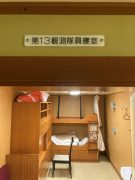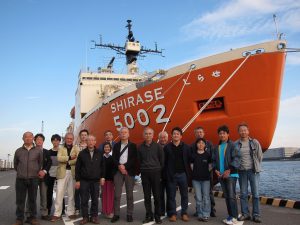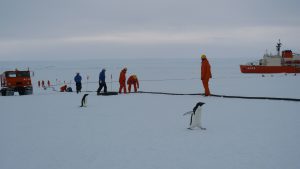観測隊員名簿はこちら。(OB会サイト)調べ物をする時などに重宝。
(以下掲載記事は記載漏れや記載忘れがあり、全ての情報を網羅していませんので予め了承ください。)
[31次隊]
31周年の集いを2022年10月29日 船橋の旧しらせ で行いました。コロナ第8波流行前でしたが念願の集いが出来て良かったと思います。

しらせ健在ですね。


夕刻のしらせも良いですね。

この日、希望者は船に1泊出来ました。自分が使った部屋で寝ることが出来ます。

岸壁沿いにはサッポロビール園のレストランがあり、そこでBBQをしました。
(他界された方)
越冬メンバーでは、神田博(ドクター)と清水隆(ターさん)、小野さん(観測主任)です。
佐野副隊長(2016)
[44次隊]
小島隊長 2017年 退官。
大下さん:2017年1月大阪と飲みました。
NIPRを辞め、職業訓練学校に通った後、沖縄で生活。2020年 62次隊に参加。
JARE44しらせ研修: 44次の集いがありました。気象の江崎さんの音頭で15周年研修会を開催。私は欠席でしたが、写真を見ると懐かしい顔がニコニコして写っています。

橋田さん:62次隊長。
[48次隊]
2022.06.24

前ちゃんが大阪勤務となり歓迎会を実施しました。
- 2016.07 中島さん、オガドクと3人で難波で飲みました。
- 2021.2.5 小達恒夫 隊長ご逝去。
- 通信の戸田さん4回目の越冬?ファイト!
[50次隊
- 村上さん、杉山さん 結婚おめでとう御座います。(2017.9)
- コズミックフロントに村上さん 先日コズミックフロントを見ていたら、村上さんが出ていました。近い将来訪れるであろう人口急増により、人類は地球外惑星に移住をせざる得ない状況になるといわれており、その研究チームの紹介でチームリーダーをやっていました。孫の時代にそれらの基礎研究の恩恵に預かりそうです。
長谷川さん:62、64次 調理 越冬。
樋口隊長も再び越冬。
[52次隊]
- 2016.7 長谷川シェフ(52次)は樋口隊長や梅津さんと一緒に57次で越冬。南極教室を大阪航空専門学校と実施しました。小学生ではないので気楽に趣向を凝らしてやってもらいました。
- 市ちゃん(庶務)が結婚。おめでとうございます。
近藤さん:62、64次 越冬。

